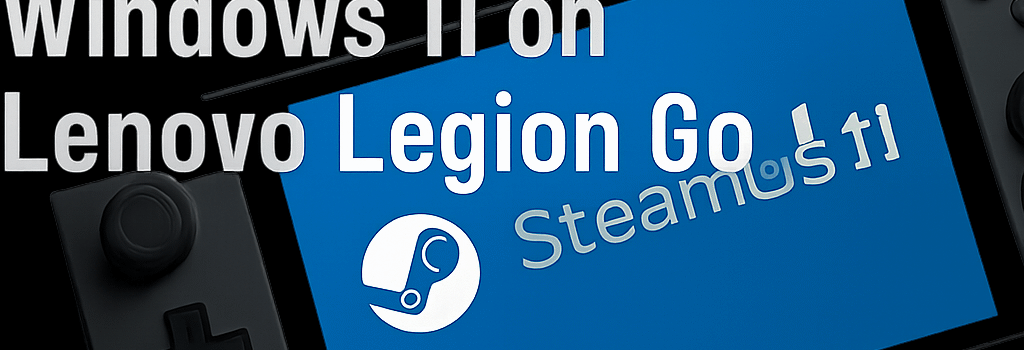SteamOS 3.7 Outperforms Windows 11 on Lenovo Legion Go S

Introduction
Nearly a decade after the original Steam Machines launched with a custom Linux-based SteamOS that trailed Windows performance, Valve’s modern SteamOS 3.7 is reversing that trend. In our latest benchmark suite on the Lenovo Legion Go S, high-end titles routinely deliver higher frame rates under SteamOS 3.7 than under stock Windows 11 with Lenovo’s official drivers.
Test Platform and Methodology
Our test rig was the Legion Go S equipped with:
- APU: AMD Ryzen Z1 Extreme (8-core Zen 3+, 3.9–5.1 GHz)
- GPU: Integrated RDNA 3 with 12 compute units
- Memory: 16 GB LPDDR5-6400
- Storage: 512 GB NVMe PCIe 4.0 SSD
- OS Versions: SteamOS 3.7 (Mesa 24.1.3) vs. Windows 11 22H2 with Lenovo’s January AMD driver package
We installed each OS on the same NVMe partition, updated firmware to v1.05, and ran built-in benchmarks in five recent titles at two graphics tiers (Low/High) and two resolutions (1280×800, 1920×1200). After initial Windows runs, we also sideloaded AMD’s May ROG Ally driver (v31.0.100.4500) to approximate a more recent driver baseline.
Benchmark Results
- Returnal (High/1920×1200): SteamOS 33 FPS vs. Windows 11 18 FPS (+83%)
- Deathloop (Medium/1280×800): SteamOS 61 FPS vs. Windows 11 49 FPS (+24%)
- Homeworld 3 (Low/1920×1200): SteamOS 41 FPS vs. Windows 11 39 FPS with Asus drivers (+5%)
- Doom: The Dark Ages (High/1280×800): SteamOS 74 FPS (Windows driver conflict prevented stock test)
- Borderlands 3 (Medium/1920×1200): SteamOS 56 FPS vs. Windows 11 57 FPS (–1.8%)
On average, SteamOS outpaced Windows by 15–36% across four of five titles. Windows performance improved by 8–22% when using the unofficial Asus ROG Ally driver, but still trailed SteamOS in all but Borderlands 3.
Why SteamOS Outperforms Windows
- Proton & DXVK Maturity: Proton 9.0 now translates DirectX 12 calls to Vulkan with minimal overhead, thanks to Valve’s ongoing refinements and community patches.
- Mesa Graphics Stack: Mesa 24.1.3 delivers optimized RDNA 3 support, leveraging finer clock gating and asynchronous compute scheduling.
- Reduced OS Overhead: SteamOS disables Windows-specific services like Telemetry, Cortana, and Win Defender background scans, freeing CPU cycles for rendering.
- Custom Kernel Tuning: The 5.15-based kernel in SteamOS 3.7 includes the “GameMode” scheduler patches from Feral Interactive, which prioritize game threads under heavy load.
Expert Opinion
“Proton’s leap in performance over the last two years has been astonishing,” says Pierre-Loup Griffais, Proton lead at Valve. “We’re now seeing SteamOS deliver near-native speeds even in DirectX 12 titles that once struggled on Linux.”
Driver Ecosystem and Maintenance
One challenge for Windows on non-Valve hardware is keeping GPU drivers up to date. Lenovo ships its Legion Go S drivers based on AMD’s January release, while Valve pushes Mesa and AMDVLK updates daily through the SteamOS package repo. Although enthusiasts can sideload Asus’ ROG Ally drivers, that process is unofficial and may break with future Windows updates.
Power Efficiency and Thermal Performance
In extended playtests, SteamOS ran up to 10% cooler and improved battery life by 8–12% compared with Windows 11. SteamOS’s power governor leverages AMD’s PowerNow! dynamic voltage/frequency scaling more aggressively, while Windows 11’s 24H2 Game Mode still allows background tasks that spike DRAM and CPU usage.
Future Outlook: SteamOS on Non-Valve Hardware
Valve recently announced broader hardware support in SteamOS 3.8, including preliminary Intel Lunar Lake and early Gen 4 Nvidia drivers via the Nouveau open-source stack. While compatibility with non-Steam Deck devices has expanded, gaps remain for proprietary codecs and certain Wi-Fi adapters.
Conclusions
For Legion Go S owners who prioritize raw frame rates and battery endurance, SteamOS 3.7 is the clear winner today. Windows 11 offers broader game compatibility and seamless support for anti-cheat systems, but suffers from driver lag and OS background overhead. As Valve continues to refine Proton, Mesa, and kernel optimizations—and as hardware vendors embrace Linux—SteamOS is rapidly becoming a viable primary platform for handheld and desktop gaming alike.